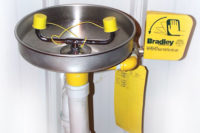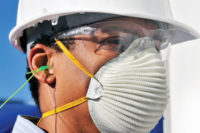It’s human nature. We’re conditioned to scan for “out-of-place†situations. This scanning allows us to move on if all seems right.
But our ability to look past certain things can lead to problems in some areas… like emergency equipment maintenance. Changes and deterioration can often be hidden from view or occur over a protracted period, so nothing seems unusual. In these instances, it might take more focused attention or even an objective third-party evaluation to assure that all is well.
According to ANSI
ANSI Z358.1-2004 (section 4.6.2 and others) specifies that emergency showers, eyewashes and combination units “shall be activated weekly for a period long enough to verify operation and ensure that flushing fluid is available.â€But what about other aspects of emergency equipment design, installation and operation? How about things like the requisite ten second, unimpeded access to emergency showers and/or eyewashes? Is it possible that uninformed employees might have inadvertently placed obstacles in the path to emergency assets? You bet!
It’s also possible that the condition of the spray heads has been altered by mineral build-up around the small holes designed to diffuse the spray pattern. So slowing down and considering everything in the environment should also be part of the weekly review — conducted by people who notice everything, using a checklist that assures that all required elements are reviewed.
ANSI Z358.1 also specifies that a more detailed evaluation of emergency equipment facilities must be done annually. This includes: individual shower/eyewash and total system overall operation, possible impacts of multiple simultaneous use of shower and/or eyewash equipment, physical installation of equipment, accessibility versus the standard minimums, establishing whether specific pieces of equipment are obsolete versus current standard requirements and overall owner/management compliance to the standard.
It’s a good idea to have your annual inspection done by an outside party knowledgeable on the specifics of the standard and how it applies to various operations. Emergency equipment manufacturers are qualified to provide this service to customers.
“Real world†audits
During the annual safety survey, specific facility, drench shower and eyewash product capability and owner/management responsibilities are reviewed versus standard requirements. A quality survey also assesses how the equipment is used from a “real world†use perspective. Some examples might include:
In the end, it’s healthy to realize that human nature allows us to overlook potential problems in the things we deal with every day, and that we might need a fresh set of eyes to assure an objective evaluation of our emergency preparedness. That’s certainly true of the required annual evaluation, where obsolescence and changes to the ANSI standard will often change circumstances more dramatically than you might think.
For more information on the emergency equipment products available or to request assistance with an annual safety survey please visit www.hawsco.com/re.

